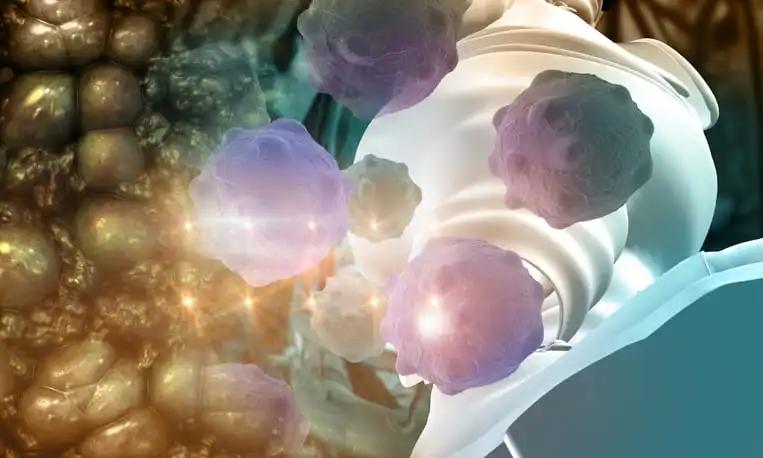KEY TAKEAWAYS
- The MagnetisMM-3 phase II study assessed the efficacy and safety of elranatamab monotherapy in RRMM patients.
- The study demonstrated that elranatamab remained effective and well-tolerated in RRMM patients, after a year of follow-up.
The phase II study presented results for relapsed or refractory multiple myeloma (RRMM) patients (pts) naïve to BCMA-directed treatments (Cohort A) after > 1 y of follow-up, including individuals who transitioned from weekly (QW) to bi-weekly (Q2W) elranatamab administration.
The study enrolled pts who were refractory to at least one proteasome inhibitor, one immunomodulatory medication, and one anti-CD38 antibody—treatment involved subcutaneous (SC) injections of elranatamab in 28-day cycles. Initial dosages were 12 mg on Day 1 of Cycle 1 (C1D1), escalated to 32 mg on Day 4 of Cycle 1 (C1D4), and finally to 76 mg weekly starting from Day 8 of Cycle 1 (C1D8). For those treated for six cycles who achieved a partial response (PR) or better, which lasted for at least two months, the dosing schedule was changed to 76 mg bi-weekly. Analyses for efficacy and safety include 46 and 58 pts, respectively, who switched to the bi-weekly regimen.
In total, 123 individuals were treated with elranatamab, with a median age of 68 years, ranging from 36 to 89. Approximately 63.4% of these pts had an ECOG PS score of 1 or higher. On average, pts had undergone five prior lines of treatment, ranging from 2 to 22. Notably, 96.7% were resistant to treatments from three different drug classes, while 42.3% were resistant to five different types of drugs. By the 12-month data cutoff, the average duration of follow-up was around 12.8 months. About 34.1% of pts were still receiving treatment at that time. The main reasons for stopping treatment were disease progression (39.0%) and adverse events (13.8%).
According to a blinded independent central review (BICR), the objective response rate was 61%, with complete response (CR) or stringent complete response (sCR) seen in 31.7% of pts. Very good partial response (VGPR) and PR were noted in 23.6% and 5.7% of pts, respectively. Among those evaluated for minimal residual disease (MRD), 92.0% achieved MRD-negativity. The median duration of response (mDOR) remains undefined, with a 12-month DOR of 74.1%. For patients achieving CR/sCR, or VGPR, the mDOR was not reached at the 12-month mark. In contrast, those with PR had a mDOR of 5.2 months (95% CI 1.6–NE). Of the 46 individuals verified as responders by BICR who switched to Q2W dosing at least 24 weeks before data cutoff, 80.4% either maintained or improved their response 24 weeks or more after the dosing change. At the 12-month point, neither the median progression-free survival nor the median overall survival had been reached, with the respective 12-month rates being 57.1% (95% CI 47.2–65.9) and 62.0% (95% CI 52.8–70.0).
The most common Grade 3/4 treatment emergent adverse events were hematologic. Non-hematologic Grade 3/4 events occurred in at least 5% of pts and included COVID-pneumonia, hypokalemia, regular pneumonia, sepsis, hypertension, increased ALT levels, and positive SARS-COV-2 tests. The frequency of severe adverse events declined by over 10% in pts who transitioned to a bi-weekly dosing schedule.
Based on over a year of follow-up data, Elranatamab showed effectiveness and tolerance in RRMM pts. An updated analysis featuring a median follow-up duration of approximately 15 months will be provided. This includes the results for pts who transitioned to bi-weekly dosing. These findings support the ongoing development of elranatamab as a monotherapy and in conjunction with standard or innovative therapies for MM pts.
Clinical Trial: https://classic.clinicaltrials.gov/ct2/show/NCT04649359
Mohty, M., Tomasson, M.H., Arnulf, B., Bahlis, N.J., Rodríguez-Otero, P., Martinez-Lopez, J., Touzeau, C., Quach, H., Depaus, J., Yokoyama, H., Manier, S., Raje, N., Raab, M.S., Searle, E., Leip, E., Sullivan, S.T., Czibere, A., Viqueira, A., Lesokhin, A. ELRANATAMAB, A B-CELL MATURATION ANTIGEN (BCMA)-CD3 BISPECIFIC ANTIBODY, FOR PATIENTS WITH RELAPSED/REFRACTORY MULTIPLE MYELOMA: EXTENDED FOLLOW UP AND BIWEEKLY ADMINISTRATION FROM MAGNETISMM-3.



